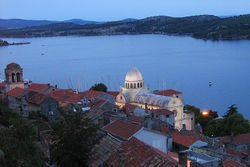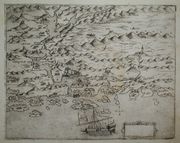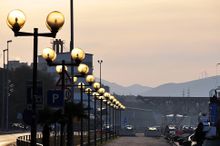Šibenik
| Šibenik | |||
|---|---|---|---|
| — Town — | |||
 |
|||
|
|||
 Šibenik
|
|||
| Coordinates: | |||
| Country | Croatia | ||
| County | Šibenik–Knin County | ||
| Government | |||
| - Mayor | Ante Županović, SDP | ||
| Population (2006)[1] | |||
| - Total | 51,553 | ||
| Time zone | CET (UTC+1) | ||
| - Summer (DST) | CEST (UTC+2) | ||
| Postal code | 22000 | ||
| Website | http://www.sibenik.hr/ | ||
Šibenik (Croatian pronunciation: [ˈʃi̩benik]; Italian: Sebenico) is a historic town in Croatia, with population of 51,553 (2001). It is located in central Dalmatia where the river Krka flows into the Adriatic Sea. Šibenik is a political, educational, transport, industrial and tourist center of Šibenik-Knin county.
Contents |
History

Šibenik was mentioned for the first time under its present name in 1066 in a Charter of the Croatian King Petar Krešimir IV. For a period of time, it was a seat of the Croatian King. For that reason, Šibenik is also called "Krešimirov grad" (Krešimir's city). It is the oldest native Croatian town on the eastern shores of the Adriatic.
Šibenik was given the status of a town and its own diocese in 1298. Excavations of the castle of Saint Michael have since proven that the place was inhabited long before the actual arrival of the Croats. The city, like the rest of Dalmatia, resisted the Venetians up to 1412. The Ottoman Empire started to threaten Šibenik at the end of the 15th century, but they never succeeded in conquering it. In the 16th century, St. Nicholas Fortress was built and, by the 17th century, its fortifications were improved again by the fortresses of St. John (Tanaja) and Šubićevac (Barone).
The fall of the Venetian Republic in 1797 brought Šibenik under the authority of the Habsburg Monarchy. After World War I, Šibenik became a part of the Kingdom of Yugoslavia, while during World War II it was occupied by Fascist Italy and Nazi Germany. During Allied bombing of the city, the Church of Sveti Nikola (Saint Nicholas) in the Mandalina settlement was destroyed.[2] After WWII it became a part of the SFR Yugoslavia until Croatia declared independence in 1991.
During the Croatian War of Independence (1991–1995), Šibenik was heavily attacked by the Yugoslav National Army and Serbian paramilitary troops. Although under-armed, the nascent Croatian army and the people of Šibenik managed to defend the city. The battle lasted for six days (September 16–22) is often referred to as the "September battle". The bombings damaged numerous buildings and monuments, including the dome of the cathedral and the 1870-built theatre building.
In an August 1995 military operation, Croatian Army defeated the Serb forces and freed the occupied areas, which created the basic conditions for its post-war recovery and allowed the region to continue to develop as the centre of Šibenik-Knin county. Architecturally, the damaged parts of the city have been fully reconstructed.
Main sights
- The central church in Šibenik, the Cathedral of St. James, is on the UNESCO World Heritage list. Several successive architects built it completely in stone in the 15th and 16th centuries, both in Gothic and in Renaissance style. The interlocking stone slabs of the Cathedral's roof were damaged when the city was shelled by Serbian forces in 1991. The damage has since been repaired.
- On the island of Prvić in Šibenik archipelago inventor Fausto Veranzio was buried and had a summer residence there.
Fortifications in Šibenik
In the town of Šibenik there are four fortresses:
- St. Nicholas Fortress (Croatian: Tvrđava Sv. Nikole) is a fortress located at sea, at the entrance of Šibenik's port.
- Tvrđava Sv. Mihovila
- Tvrđava Sv. Ivana
- Tvrđava Šubićevac
Natural heritage
- A couple of kilometers north of the city is the Krka National Park, similar to the more famous Plitvice Lakes National Park, renowned for its many waterfalls, flora, fauna, and historical and archaeological remains.


- The Kornati archipelago, west of Šibenik, consists of 150 islands in a sea area of about 320 km², making it the densest archipelago in the Mediterranean Sea.[3]
- Island Prvić that is protected as a cultural heritage by Ministry of Culture of Croatia. On the island the famous polymath and inventor Fausto Veranzio is buried[4].
Culture and events
The annual Šibenik International Children's Festival (Međunarodni Dječji Festival) takes place every summer.
The composer Jakov Gotovac founded the city's "Philharmonia Society" in 1922. The composer Franz von Suppé was part of the city's cultural fabric, as he was a native of nearby Split.
Population
Šibenik's town population is estimated to be 37,124 as of 2007.[5] In the 2001 census, population of the town was 37,060 while the population of the municipality was 51,553. The majority of its citizens are Croats, with 94.02% (2001 census).
Utilities
The town of Šibenik was the first city in the world to receive a polyphase system of alternating current. The system supplied 340 street lights and some electrified houses in the town.
International relations
Šibenik is twinned with:
Notable people
- Peter Krešimir IV of Croatia, King of Croatia
- St. Nikola Tavelić, first Croatian saint
- Faust Vrančić, inventor
- Antun Vrančić, writer
- Martino Rota, engraver
- Natale Bonifazio, woodcarver
- Giorgio da Sebenico, architect and sculptor
- Roberto Ferruzzi, painter
- Krešimir Baranović, composer and conductor
- Ester Mazzoleni, opera singer
- Mišo Kovač, singer
- Miloš Macura, musician
- Arsen Dedić, musician
- Branko Bubica, tenor
- Radoslav Koštan, tenor
- Niccolò Tommaseo, Dalmatian Italian linguist and journalist
- Roberto de Visiani, botanist
- Angelo Antonio Frari, famous physician, epidemiologist, historian of medicine, and protomedicus of Venice
- Dražen Petrović, basketball player
- Ivo Brešan writer
- Goran Višnjić, actor, best known for his role on ER
- Branko Grgić, former president of Hajduk Split
- Perica Bukić, former water polo player and politician
- Maksim Mrvica, pianist
- Ante Rukavina, football player
- Gordon Schildenfeld, football player
- Anthony Maglica, inventor
- Danira Gović, actress
- Giorgio Sisgoreo, poet
- Neven Jakovljević, painter
References
- ↑ "Population contingents, by towns/municipalities, census 2001". Croatian Bureau of Statistics. http://www.dzs.hr/Eng/censuses/Census2001/Popis/E01_01_02/e01_01_02_zup15.html. Retrieved 2008-12-29.
- ↑ Mandalina: crkva s vidikovcem, Slobodna Dalmacija
- ↑ Skračiċ, Vladimir (2003). Kornat Islands. Zadar: Forum. ISBN 953-179-600-9.
- ↑ http://www.prvicluka.info/en
- ↑ http://www.world-gazetteer.com/wg.php?x=&men=gcis&lng=en&dat=32&srt=npan&col=aohdq&geo=-98
- ↑ "Civitanova Marche — Twin Towns". Civitanova Marche. http://www.comune.civitanova.mc.it/index.php?option=com_content&task=view&id=685&Itemid=238. Retrieved 2008-12-04.
External links
- Official Šibenik City website
- Croatia on Facebook
- Adriatic Sea on Facebook
- Croatian Tourist Board
- CroTouristica.com - Šibenik tourist info
- Šibenik Foto Gallery
- Šibenik on-line
- Šibenik City and Šibenik Riviera
- Historic centre of Šibenik at night - Foto Gallery
 Media related to Šibenik at Wikimedia Commons
Media related to Šibenik at Wikimedia Commons Chisholm, Hugh, ed (1911). "Sebenico". Encyclopædia Britannica (Eleventh ed.). Cambridge University Press.
Chisholm, Hugh, ed (1911). "Sebenico". Encyclopædia Britannica (Eleventh ed.). Cambridge University Press.
|
||||||||||||||||
|
||||||||
